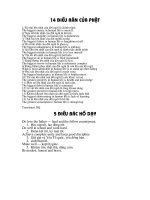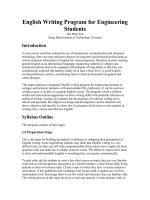- Trang chủ >>
- Văn Mẫu >>
- Văn Thuyết Minh
this site is individual site for ueh students of information management faculty this site provides some students resources of it courses such as computer network data structure and algorithm enterprise resource planning
Bạn đang xem bản rút gọn của tài liệu. Xem và tải ngay bản đầy đủ của tài liệu tại đây (125.84 KB, 11 trang )
<span class='text_page_counter'>(1)</span><div class='page_container' data-page=1>
© Copyright IBM Corporation 2004
Course materials may not be reproduced in whole or in part without the prior written permission of IBM.
<i>Welcome to:</i>
3.1
<b>XM30 Introduction to XML and Related </b>
<b>XM30 Introduction to XML and Related </b>
<b>Technologies</b>
</div>
<span class='text_page_counter'>(2)</span><div class='page_container' data-page=2>
<b>Introduction</b>
XM301 Introduction to XML and Related Technologies
Instructor:
Please introduce yourself and provide your:
Name and organization
Job Role
</div>
<span class='text_page_counter'>(3)</span><div class='page_container' data-page=3>
© Copyright IBM Corporation 2004
<b>Course Description</b>
This course is designed to introduce students to the fundamentals
of XML and its significant derivative companion technologies: XML
Schema, Namespaces, XPath, and XSL Transformations.
Document Type Declarations (DTDs) are also introduced.
The focus of the course is on the creation, specification and
processing of XML documents.
The course is 2.5 days in length and provides extensive hands-on
labs throughout.
</div>
<span class='text_page_counter'>(4)</span><div class='page_container' data-page=4>
<b>Audience</b>
</div>
<span class='text_page_counter'>(5)</span><div class='page_container' data-page=5>
© Copyright IBM Corporation 2004
<b>Prerequisites</b>
Prerequisites:
</div>
<span class='text_page_counter'>(6)</span><div class='page_container' data-page=6>
<b>Course Objectives (1 of 2)</b>
After completing this course, you should be able to:
Describe/differentiate the use of HTML and XML
Enumerate the rules of a well-formed XML document
Create and maintain XML documents
Describe the purpose and use of Document Type Definitions
(DTDs)
Create DTDs describing the validation rules for specific XML
instances*
Describe the purpose and use of XML Schema
Enumerate the benefits of XML Schema over DTDs
Create XML Schemas describing the validation rules for specific
XML instances*
</div>
<span class='text_page_counter'>(7)</span><div class='page_container' data-page=7>
© Copyright IBM Corporation 2004
<b>Course Objectives (2 of 2)</b>
After completing this course, you should be able to:
Describe the purpose of XML Namespaces
Declare and use XML Namespaces in an XML document*
Describe the use of an XPath in the context of XSLT and XML
Schema
Create XPath expressions that locate specific information in an
XML instance*
Describe the use of XSL in the processing of XML documents
Create an XSL Transformation to transform an XML document
into some other instance*
</div>
<span class='text_page_counter'>(8)</span><div class='page_container' data-page=8>
<b>Agenda - Day 1</b>
Welcome and Introductions
Issues in Information Exchange
What is XML?
Lab Exercise
Overview of IBM WebSphere Studio Application Developer
Lab Exercise
Document Type Definitions
Lab Exercise
</div>
<span class='text_page_counter'>(9)</span><div class='page_container' data-page=9>
© Copyright IBM Corporation 2004
<b>Agenda - Day 2 </b>
XML Schema
Lab Exercise
XPath
Lab Exercise
</div>
<span class='text_page_counter'>(10)</span><div class='page_container' data-page=10>
<b>Agenda - Day 3</b>
</div>
<span class='text_page_counter'>(11)</span><div class='page_container' data-page=11>
© Copyright IBM Corporation 2004
<b>Unit Summary</b>
We've looked at the overall course objectives and a day-by-day
agenda.
</div>
<!--links-->









